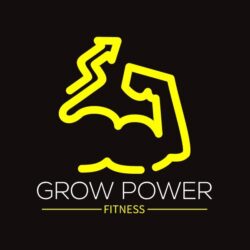When it comes to strength training exercises, few are as effective and versatile as the squat. Not only does it target multiple muscle groups, but it also plays a crucial role in functional movement and athletic performance. However, to reap the full benefits and avoid potential injuries, it is essential to learn and practice proper squat form. In this article, we will delve into the intricacies of executing a squat with impeccable technique and provide valuable insights to help you maximize your gains safely.
Benefits of Proper Squat Form
Before diving into the specifics of proper squat form, it’s important to understand why it matters. By performing squats correctly, you can unlock a wide range of benefits that go beyond mere muscle development.
Muscular Strength and Development
Squats are renowned for their ability to target various muscle groups simultaneously. When executed with proper form, they engage the quadriceps, hamstrings, glutes, and calves, promoting balanced lower body strength and hypertrophy. Additionally, squats activate the core muscles, including the abdominals and lower back, fostering overall stability and power.
Improved Functional Movement
Mastering the squat form translates into improved functional movement. As a compound exercise, squats mimic everyday activities like sitting, standing, and lifting objects from the ground. By honing your squat technique, you enhance your ability to perform these movements safely and efficiently, making your daily tasks easier and reducing the risk of strain or injury.
Enhanced Athletic Performance
Athletes across various disciplines rely on squats to boost their performance. The explosive power generated during a squat transfers to activities that require lower body strength, such as jumping, sprinting, and change of direction. By perfecting your squat form, you can unleash your athletic potential and excel in your chosen sport or fitness pursuit.
Injury Prevention
Practicing squats with proper form acts as a protective measure against injuries. By maintaining correct alignment and distributing the load evenly, you reduce excessive stress on your joints and ligaments. This helps prevent common injuries such as knee pain, lower back strains, and muscle imbalances. Proper squat form ensures that the forces generated during the movement are appropriately distributed throughout your lower body, minimizing the risk of overloading specific areas.
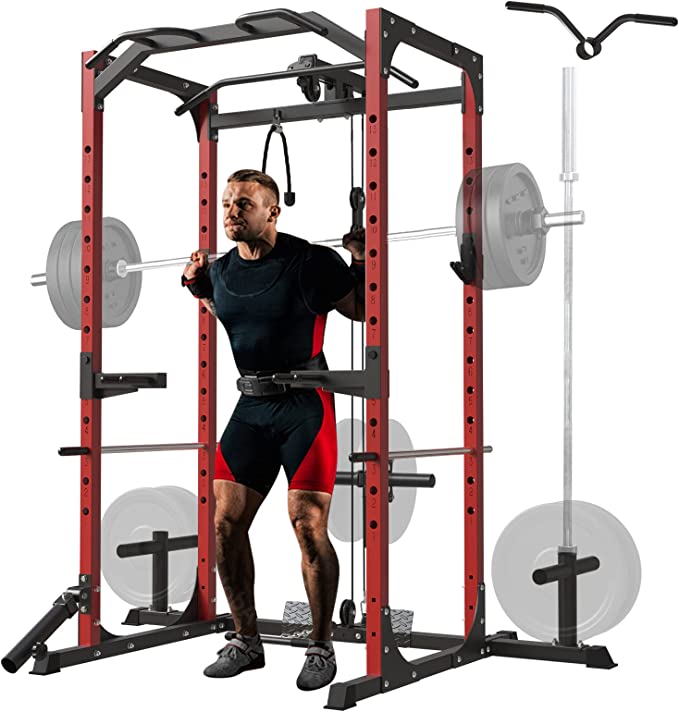
Mikolo Power Cage, Power Rack with LAT Pulldown, Multi-Functional Squat Rack with 230 Pounds Olympic Weight Plates Sets, Squat Cage with More Training Attachments for Home Gym, F4 Versions
Key Components of Proper Squat Form
To execute a squat with optimal form, it’s crucial to pay attention to several key components. By understanding and implementing these principles, you can perform squats safely and effectively.
Foot Placement and Alignment
Begin by positioning your feet shoulder-width apart or slightly wider. Point your toes slightly outward, maintaining a neutral alignment between your knees and feet. This stance provides a stable base of support and allows for proper tracking of your knees throughout the movement.
Hip and Knee Positioning
During the squat, focus on sitting back and down, as if you were sitting into an imaginary chair. Engage your glutes and hips, ensuring they initiate the movement. As you descend, your knees should track in line with your toes, without collapsing inward or excessively shifting forward.
Back and Torso Alignment
Maintaining a neutral spine is paramount during squats. Keep your chest lifted and your upper back engaged. Avoid rounding your lower back or excessively arching it. A slight natural curve should be maintained throughout the movement to protect your spine and optimize force transfer.
Breathing Technique
Proper breathing technique contributes to stability and core engagement during squats. Take a deep breath before descending, filling your abdomen and ribcage with air. Hold your breath as you descend and ascend, maintaining intra-abdominal pressure. Exhale at the top of the movement and repeat the process for each rep.
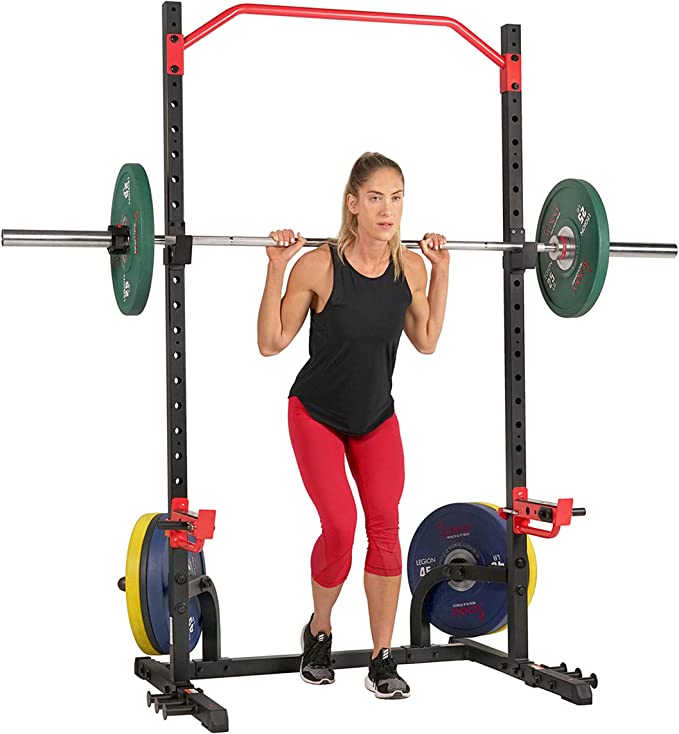
Sunny Health & Fitness Power Zone Squat Stand Power Rack, Power Cage
Step-by-Step Guide to Performing a Squat with Proper Form
Now that we have covered the key components of proper squat form, let’s break down the step-by-step process for executing a squat correctly:
- Warm-up and Preparation: Before starting your squats, warm up your body with light cardio exercises and dynamic stretches. This helps increase blood flow, loosen up your muscles, and prepare your body for the movement.
- Feet Placement and Alignment: Stand with your feet shoulder-width apart or slightly wider. Position your toes outward at a comfortable angle.
- Hip and Knee Positioning: Initiate the movement by pushing your hips back, as if you are sitting back into a chair. Bend your knees and lower yourself down while keeping your chest lifted and your back straight. Ensure that your knees track in line with your toes.
- Back and Torso Alignment: Maintain a neutral spine throughout the movement. Avoid rounding or arching your lower back. Keep your chest up and engage your core to support your posture.
- Execution of the Squat: Continue descending until your thighs are parallel to the ground or slightly below. Pause for a brief moment, then drive through your heels to push yourself back up to the starting position. Keep your movements controlled and avoid bouncing at the bottom of the squat.
- Breathing Technique: Inhale deeply before descending and hold your breath as you go down and come back up. Exhale at the top of the movement.
- Common Mistakes to Avoid: Be mindful of common mistakes such as rounding your back, allowing your knees to cave in, or shifting your weight too far forward. Focus on maintaining proper form throughout the entire range of motion.
Tips for Improving Squat Form
To enhance your squat form and maximize the benefits, consider the following tips:
Mobility and Flexibility Exercises
Perform regular mobility and flexibility exercises to improve your squat range of motion. Target areas such as your hips, ankles, and thoracic spine through exercises like foam rolling, hip stretches, ankle mobility drills, and thoracic spine rotations. By addressing any mobility restrictions, you can achieve better squat depth and maintain proper form throughout the movement.
Strengthening Supporting Muscles
Incorporate exercises that target the muscles supporting your squat, such as the glutes, hamstrings, and core. By strengthening these areas, you improve stability and control during the squat. Include exercises like hip thrusts, Romanian deadlifts, and planks in your training routine.
Gradual Progression and Load Management
Gradually increase the weight and intensity of your squats over time. Progressing too quickly can compromise form and increase the risk of injury. Listen to your body, and ensure you can maintain proper technique before adding more weight. Additionally, pay attention to proper rest and recovery to allow your muscles to adapt and grow stronger.
Seeking Professional Guidance
If you’re new to squats or struggling with your form, consider seeking guidance from a qualified fitness professional. They can assess your technique, provide personalized recommendations, and correct any form issues. Working with a knowledgeable coach can help you progress safely and effectively in your squat journey.
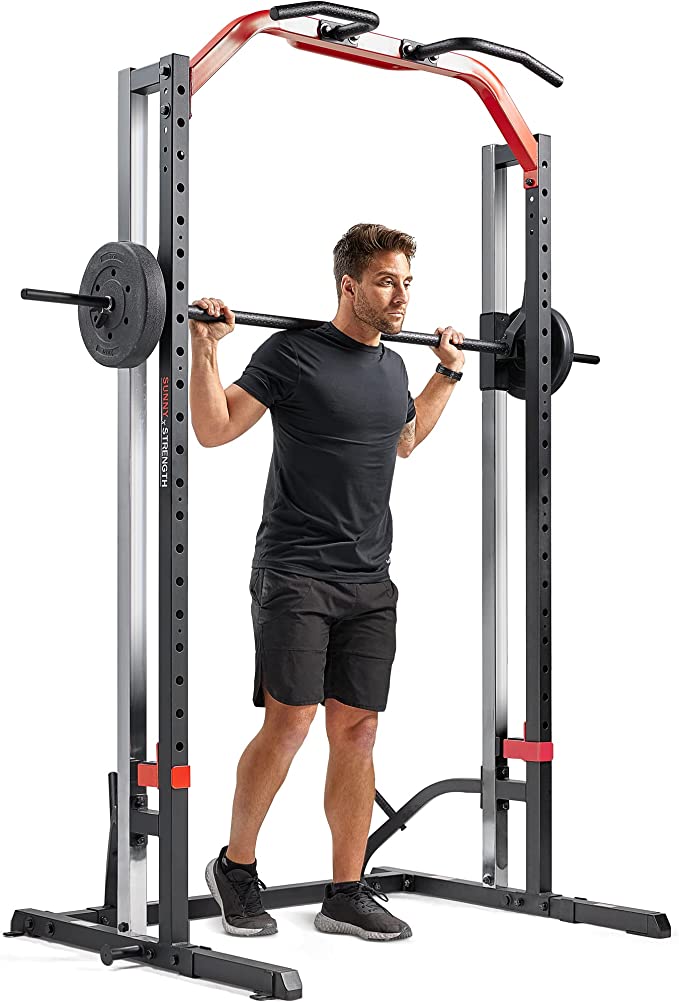
Sunny Health & Fitness Premium Squat Smith Machine Power Rack
Troubleshooting Common Squat Form Issues
Despite your best efforts, you may encounter certain squat form issues. Here are some common problems and how to address them:
Heels Lifting off the Ground
If your heels lift off the ground during squats, it could indicate ankle mobility limitations. Strengthening your ankles through exercises like calf raises and incorporating ankle mobility drills can help improve this issue. Additionally, wearing weightlifting shoes with elevated heels can provide added stability and improve your squat mechanics.
Knees Caving Inwards
Allowing your knees to cave in is often a result of weak hip muscles or poor activation. Strengthen your glutes and hip abductors with exercises like clamshells, lateral band walks, and squats with resistance bands. Focus on pushing your knees out during the squat to maintain proper alignment.
Excessive Forward Lean
An excessive forward lean can strain your lower back and compromise form. To address this, strengthen your core muscles and work on thoracic spine mobility. Incorporate exercises like planks, Russian twists, and thoracic extensions to improve your core stability and upper body posture.
Rounded Back
Rounding your back during squats can lead to spinal injuries. Focus on maintaining a neutral spine throughout the movement. Strengthen your core, practice proper breathing techniques, and reduce the weight or range of motion if necessary. If you continue to struggle with back rounding, consult a fitness professional for further evaluation and guidance.
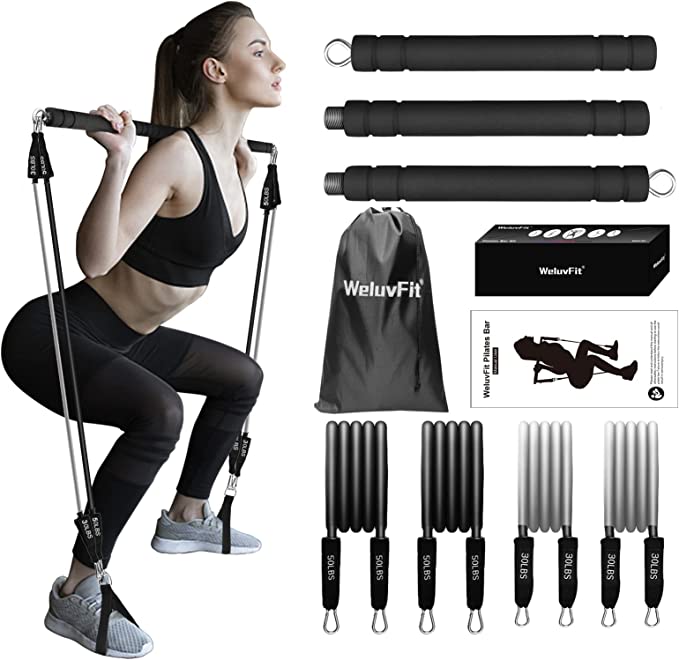
Pilates Bar Kit with Resistance Bands, WeluvFit Exercise Fitness Equipment for Women & Men, Home Gym Workouts Stainless Steel Stick Squat Yoga Pilates Flexbands Kit for Full Body Shaping
Incorporating Squats into a Fitness Routine
To incorporate squats effectively into your fitness routine, consider the following factors:
Sets, Repetitions, and Rest Periods
The specific number of sets and repetitions will depend on your fitness goals and training program. Generally, aim for 3-5 sets of 8-12 repetitions to build strength and hypertrophy. Rest for 1-2 minutes between sets to allow for adequate recovery.
Variation and Progression
Explore different squat variations to target your muscles from various angles and challenge your body in new ways. Some popular variations include front squats, goblet squats, and Bulgarian split squats. Gradually increase the load, intensity, or difficulty of your squats over time to promote continuous progress and adaptation.
Conclusion
Mastering proper squat form is a fundamental aspect of strength training. By focusing on foot placement, hip and knee positioning, back and torso alignment, and breathing technique, you can perform squats with optimal efficiency and safety. Incorporate the provided tips, troubleshoot common form issues, and implement strategies to improve your squat form. Remember to prioritize mobility, strengthen supporting muscles, and progress gradually to avoid injuries and maximize results.
Squats offer an array of benefits, from building muscular strength and enhancing functional movement to boosting athletic performance and preventing injuries. By practicing proper squat form, you’ll not only achieve better results but also reduce the risk of setbacks.
Now that you have a comprehensive understanding of proper squat form, take this knowledge and apply it to your training routine. Remember to focus on each component, from foot placement to breathing technique, and strive for consistency in your form.
So why wait? Start incorporating squats with proper form into your workouts and experience the transformative power they have on your fitness journey.
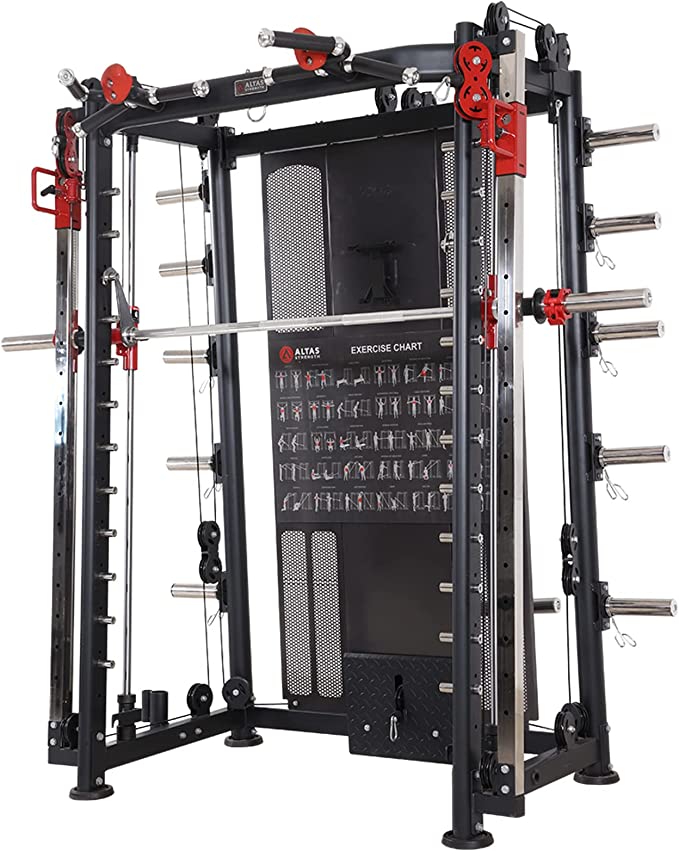
Altas Strength Home Gym Equipment Smith Machine with Pulley System Gym Squat Rack Pull Up Bar Upper Body Strength Training Leg Developer Light Commercial Fitness Equipment Included Accessories 3000Y
FAQs (Frequently Asked Questions)
How deep should I squat?
The depth of your squat depends on your mobility, flexibility, and comfort level. Aim to squat until your thighs are parallel to the ground or slightly below, ensuring proper form and avoiding excessive strain on your joints.
Should I use a weightlifting belt when squatting?
Weightlifting belts can provide additional support and stability during heavy squats. However, they should not be relied upon as a substitute for proper form and core strength. Use a weightlifting belt if it helps you maintain proper technique, but don’t become dependent on it.
Can squatting with improper form cause knee pain?
Yes, squatting with improper form, such as allowing your knees to collapse inward or placing excessive stress on your joints, can lead to knee pain and injuries. It is crucial to prioritize proper form and alignment to protect your knees during squats.
Are squats only beneficial for lower body development?
Squats primarily target the lower body, including the quadriceps, hamstrings, glutes, and calves. However, they also engage the core muscles and promote overall strength and stability. Squats are a compound exercise that provides benefits beyond just lower body development.
Can I do squats if I have a previous injury?
If you have a previous injury, it is essential to consult with a healthcare professional or a qualified trainer before incorporating squats into your routine. They can assess your condition, provide modifications, and guide you on how to perform squats safely while considering your specific needs.
Remember, mastering proper squat form is a journey that requires patience, practice, and attention to detail. With dedication and focus, you can unlock the full potential of this incredible exercise and enjoy the numerous benefits it offers.

French Fitness FSR90 Functional Trainer Smith & Squat Rack Machine (New)
